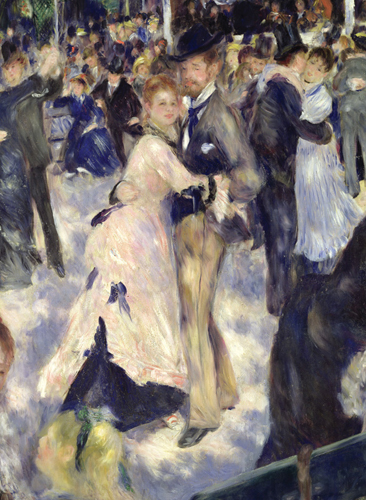Musée d’Orsay
This wonderful collection covers a variety of art forms from the 1848–1914 period, including a superb Impressionists section. Its setting, in a converted railway station, is equally impressive. Built in 1900, in time for the Paris Exposition, the station was in use until 1939, when it was closed and largely ignored, bar its use as the location for Orson Welles’ 1962 film, The Trial. It was later used as a theatre and as auction rooms, and in the mid-1970s was considered for demolition. In 1977, the Paris authorities decided to save the imposing station building by converting it into this striking museum.
|
Gallery GuideAs soon as you enter the gallery, collect a map of its layout. Escalators near the entrance lead to all three floors. The ground floor houses fine works from the early to mid-19th century, as well as striking Oriental works, decorative arts and a book shop. The middle level includes Naturalist and Symbolist paintings and sculpture terraces. The upper level is home to the Impressionist and Post-Impressionist galleries. Some rooms may be closed for renovation – call ahead. |

|
|
Top 10 Features
Van Gogh Paintings
The star of the collection is Vincent Van Gogh (1853–90) and the most striking of the canvases on display is the 1889 work showing the artist’s Bedroom at Arles. Also on display are self-portraits, painted with the artist’s familiar intensity (Room 35).
Le Déjeuner sur l’Herbe
Edouard Manet’s (1832–83) controversial painting (1863) was first shown in an “Exhibition of Rejected Works”. Its bold portrayal of a classically nude woman enjoying the company of 19th-century men in suits brought about a wave of criticism (Galerié Seine).
Blue Waterlilies
Claude Monet (1840–1926) painted this stunning canvas (1919) on one of his favourite themes. His love of waterlilies led him to create his own garden at Giverny to enable him to paint them in a natural setting. This experimental work inspired many abstract painters later in the 20th century (Room 34).
Jane Avril Dancing
Toulouse-Lautrec’s (1864–1901) paintings define Paris’s belle époque. Jane Avril was a Moulin Rouge dancer and featured in several of his works, like this 1895 canvas (Room 47).
La Belle Angèle
This portrait of a Brittany beauty (1889) by Paul Gauguin (1848–1903) shows the influence of Japanese art on the artist. It was bought by Degas, to finance Gauguin’s first trip to Polynesia (Room 43).
Café des Hauteurs
As a rest from all the art, the Musée d’Orsay’s café is delightfully situated behind one of the former station’s huge clocks, making a break here an experience in itself. The food is good too.
Musée d’Orsay Collections
School of Pont-Aven
Paul Gauguin (see La Belle Angèle) was at the centre of the group of artists associated with Pont-Aven in Brittany. His work here includes the carved door panels known as the House of Pleasure (1901).
Art Nouveau
Art Nouveau is synonymous with Paris, with many metro stations retaining entrances built in that style. Pendants and bottles by René-Jules Lalique (1860–1945) are among the examples.
Symbolism
This vast collection includes works by Gustav Klimt (1862– 1918), Edvard Munch (1863–1944) and James Whistler’s (1834–1903) 1871 portrait of his mother.
Romanticism
The Romantics wanted to heighten awareness of the spiritual world. One striking work is The Tiger Hunt (1854) by Eugène Delacroix (1798–1863).
Sculpture
The collection includes pieces by Rodin and satirical carvings of politicians by Honoré Daumier (1808–79).
Naturalism
Naturalist painters intensified nature in their work. Haymaking (1877) by Jules Bastien-Lepage (1848–84) is a fine example.
Nabis
The Nabis Movement moved art into a more decorative form. Pierre Bonnard (1867–1947) is one of its exponents.
Photography Collection
Some 10,000 early photographs include work by Bonnard, Degas and photographer Julia Margaret Cameron (1815–79).
|
The Impressionist Movement
Regarded as the starting point of modern art, the Impressionist Movement is probably the best-known and best-loved art movement in the world – certainly if prices at auction and the crowds in the Musée d’Orsay’s galleries are anything to go by. The movement started in France, and almost all its leading figures were French, including the Parisian-born British artist Alfred Sisley. Impressionism was a reaction against the formality and Classicism insisted upon by the Académie des Beaux-Arts in Paris, who were very much the art establishment and decided what would or would not be exhibited at the all-important Paris Salon. The term “impressionism” was actually coined by a critic of the style, who dismissed the 1872 Monet painting Impression: Sunrise in a magazine. The artists themselves then adopted the term. The style profoundly influenced painters such as Van Gogh and was to have a lasting influence on 19th- and 20th-century art.
(Prices for Impressionist paintings are considered a financial barometer for the art world. One of Monet’s Waterlily paintings fetched almost US$80 million in 2008.)










